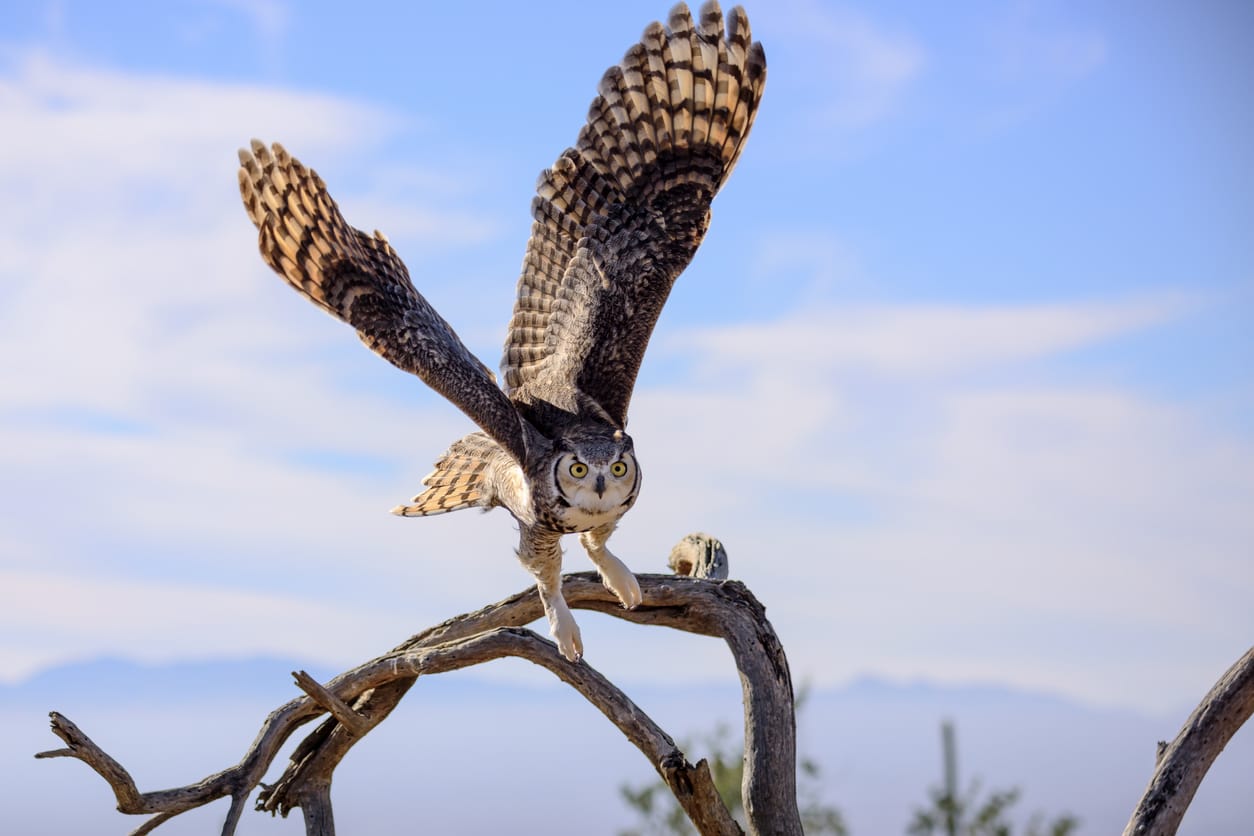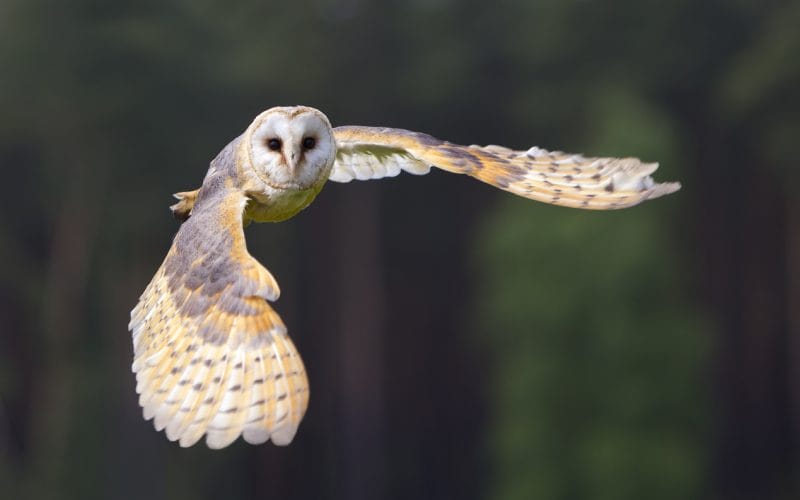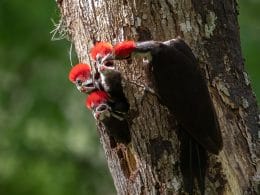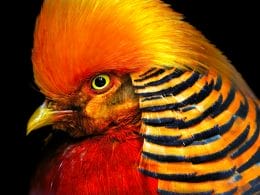There are 536 species of birds officially recorded and listed by the (FOSRC) Florida Ornithological Society Records Committee. Out of these, you can spot 10 species of owls in Florida.
Keep reading for more information on how to find and identify owls in the Sunshine State.
1. Barn Owl

Scientifically known as Tyto alba, the Barn Owl is one of the most commonly seen owl species across the whole country. In Florida, you can spot these birds all year round in clearings, farms, woodland areas, and suburbs.
Barn Owls measure around 12.6 to 15.8 inches (32 to 40 cm) long and weigh about 14.1 to 24.7 ounces (400 to 700 g). Their wingspan ranges between 39.4 and 49.2 inches (100 and 125 cm)
These numbers put Barn Owls above an Eastern Screech-Owl and below a Great Horned Owl on the size scale. As medium-sized birds, they feature long rounded wings and short tails.
Top Tip: Their legs are also long and their heads are smoothly rounded. Barn Owls don’t have ear tufts.
Although they’re non-migratory, the population of Barn Owls isn’t what it used to be in the Sunshine State due to habitat loss. As if this doesn’t make them tricky enough to find, Barn Owls also possess one of the most prominent nocturnal tendencies among all owls.
This means they rarely come out during the day, which helps them escape detection easily.
Many people describe Barn Owls as having a monkey-like face. More folks compare them to ghosts in the night because of their combination of dark bodies and distinctive white heart-shaped faces. These colors make them seem like a light silhouette against the darkness of the night.
Barn Owls have dark eyes and are generally a mixture of grey and buff shades. They’re among the easiest species of owls to identify.
The homes of Barn Owls mostly consist of tree cavities, deserted caves, empty barns, and abandoned buildings. These birds prefer building their nests close to open areas, which is where you have the highest chances of seeing them.
You may also encounter them around fields, marshes, and agricultural sites.
Mating-wise, Barn Owls pairs typically stay together for several seasons after their initial joining. As such, you can expect to come across the same couple 2 years in a row.
2. Eastern Screech-Owl

The Eastern Screech-Owl, scientifically referred to as Megascops asio, is probably the most common species of owls residing in Florida. Although you can find them in Florida any time throughout the year, your chances are highest between April and May as this period marks the bird’s breeding season.
Eastern Screech-Owls measure around 6.3 to 9.8 inches (16 to 25 cm) long and weigh about 4.3 to 8.6 ounces (121 to 244 g). Their wingspan ranges between 18.9 to 24.0 inches (48 to 61 cm).
The body of an Eastern Screech-Owls is short and stocky. It’s either mostly grey or predominantly reddish-brown (rufous), but regardless of the color, these birds show sophisticated patterns of intricate stripes and spots that provide them with an excellent disguise against tree bark.
Eastern Screech-Owls have relatively big heads with necks that seem virtually non-existent. Their small size and what appears like a permanent scowl adorning their faces only serve to make these birds of prey look rather adorable.
Additionally, this owl species features squared tails and rounded wings. They have yellow eyes and possess pointed ear tufts that are often in a raised position, giving the bird’s head a unique shape with a bit of similarity to Great Horned Owls.
Eastern Screech-Owls are nocturnal creatures, so don’t get your hopes up for spotting them in the light of day. Their habitat mainly consists of second-growth forests, especially at lower elevations.
They’re very versatile owls and can live in an array of open spaces such as suburban areas, forests, tree cavities, and swamps.
In any case, Eastern Screech-Owls are one of those birds that are more “heard” rather than “seen”. The majority of birdwatchers identify them by their distinct calls that include rattles, whinnies, moans, trills, and screeches.
3. Great Horned Owl

If you used to watch Winnie the Pooh (or still do, we won’t judge), then you’re probably familiar with the wise character Owl. Well, if you didn’t know already, that’s a Great Horned Owl.
Author Note: Although we can’t confirm or deny that members of this species can offer you the same wisdom as Owl, we’re sure they’re huge and intimidating. Their name comes from having massive tufts and their yellow eyes shine bright against the dark background.
The Great Horned Owl, scientifically named Bubo virginianus, has a length of 18.1 to 24.8 inches (46 to 63 cm) and a wingspan ranging from 39.8 to 57.1 inches (101 to 145 cm). It weighs around32.1 to 88.2 ounces (910 to 2500 g), making it the largest species of owls in the Sunshine State.
Great Horned Owls are commonly referred to as Hoot Owls or Cat Owls. They possess a greyish brown plumage all over their bodies with a contrasting white-colored patch on the throat and reddish-brown faces.
Large and thick, these birds of prey have rounded wings. What makes them truly stand out from the crowd is the pair of horn-like raised ear tufts sitting on their heads. It’s a dead giveaway if we’ve ever seen one!
Many bird watchers consider the Great Horned Owl to be the nocturnal equivalent of the Red-tailed Hawk as it also hunts for small birds and mammals but during the night. However, they may practice hunting by day, so there’s a chance you may run into them.
The habitat of a Great Horned Owl includes a wide array of places such as evergreen and deciduous forests, suburbs, swamps, parks, deserts, cites, as well as tundra edges. If you’re thinking this is one of the most habitat-adaptable species of owls, you got that right.
Sometimes these birds like to perch on tree limbs or fence posts at the perimeters of open areas, so you may spot them there. Their call is made up of a stuttering sequence of 4 to 5 hoots.
Unlike the majority of owl species you can find in the United States, this particular one loves to be seen thanks to their bold personalities and tendency of letting others know of their presence. Granted, that’s not good news for their prey, but it facilitates your mission of catching the sight of one.
4. Burrowing Owl

Are you familiar with the award-winning novel “Hoot”? Not only is it set in Florida, but it also features Burrowing Owls! Many folks give it the credit for the species’ rise to fame — that and their absolutely charming attributes.
Scientifically known as Athene cunicularia, Burrowing Owls measure 7.5 to 9.8 inches (19 to 25 cm) long and weigh 5.3 ounces (150 g). Their wingspan is around 21.6 inches (55 cm).
These birds of prey are relatively small with rounded heads, short tails, long legs, and no ear tufts. They’re mostly mottled brown with whitish spotting all over.
Their faces showcase bright yellow eyes surrounded by fluffy grey feathers, which makes them look like they have eyelashes. Additionally, Burrowing Owls feature bold white eyebrows with a pale chin and throat area.
The species’ juveniles are also brown but not as mottled as the adults. They possess buff-yellow bellies and wing patches.
Unlike the majority of owls found in the United States, Burrowing Owls prefer to stay close to the ground most of the time. They even got their name as a reference to their habit of nesting in concealed burrows in the ground.
You’re likely to spot a Burrowing Owl on the ground or sitting on low perches. Since they’re active during the day, there’s a good chance you’ll spot them easily as they hunt for insects and small animals close to the ground.
The habitat of Burrowing Owls includes open areas where vegetation is scattered such as pastures, grasslands, and deserts. In Florida, you’re more likely to spot these birds around prairies.
5. Barred Owl
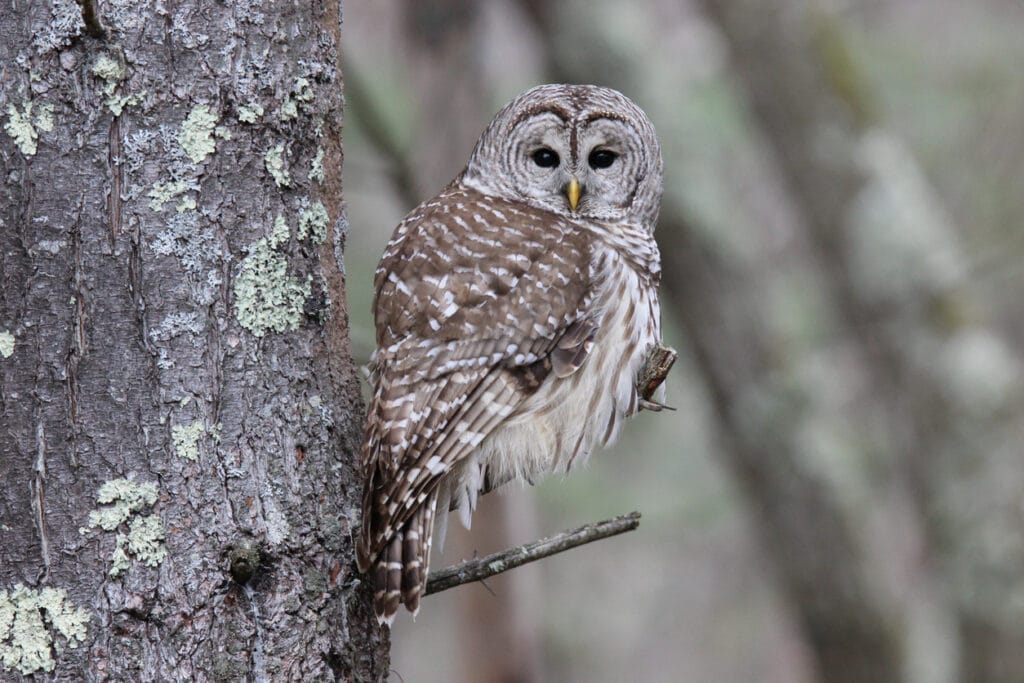
Scientifically referred to as Strix varias, the Barred Owl has a length between 16.9 to 19.7 inches (43 to 50 cm) and a wingspan between 39.0 to 43.3 inches (99 to 110 cm).
With a weight ranging between 16.6 and 37.0 ounces (470 and 1050 g), these birds of prey are larger than Barn Owls but inferior to Great Horned Owls when it comes to size.
Barred Owls have stocky, thick bodies with rounded heads and rounded tails. They don’t have ear tufts and their eyes are pitch black against a light-colored face.
Top Tip: These owls got their name from their beautiful feather patterns, appearing as alternating horizontal stripes of light and dark brown all over the back, wings, and tail.
The mottled brown and white plumage of Barred Owls have mottled brown is accompanied by a contrasting yellow beak.
One of the most unique aspects of this species of owls is their hooting call. You can hear this classic sound all year round, commonly and distinctly described as “who cooks for you, who cooks for you all?”
The preferred habitat of Barred Owls includes mature forests that house both evergreen and deciduous trees. They also like to stay near water sources, nesting mainly in tree cavities.
6. Short-eared Owl

Short-eared Owls, also called Asio flammeus in the scientific community, measure around 13.4 to 16.9 inches (34 to 43 cm) long and weigh between 7.3 and 16.8 ounces (206 and 475 g). Their wingspan ranges from33.5 to 40.5 inches (85 to 103 cm).
This medium-sized species got its name “Short-eared” from possessing very short ears that are quite challenging to see. These owls have rounded heads, short tails, and wide wings with the tips rounded.
The bodies of Short-eared Owls are brown with a white and buff-colored spotting pattern and a light belly. Their pale faces seem to carry a very “alert” look with piercing yellow eyes surrounded by contrasting black feathers.
Short-eared Owls often play dead when threatened by nearby predators. They also have a habit of pretending to be disabled before attacking prey by hopping on one leg.
In Florida, these owls are usually found in open spaces such as fields, meadows, and prairies. The best time to spot them is during the winter especially when they’re hunting at dusk and in the early morning nesting.
7. Northern Saw-whet Owl
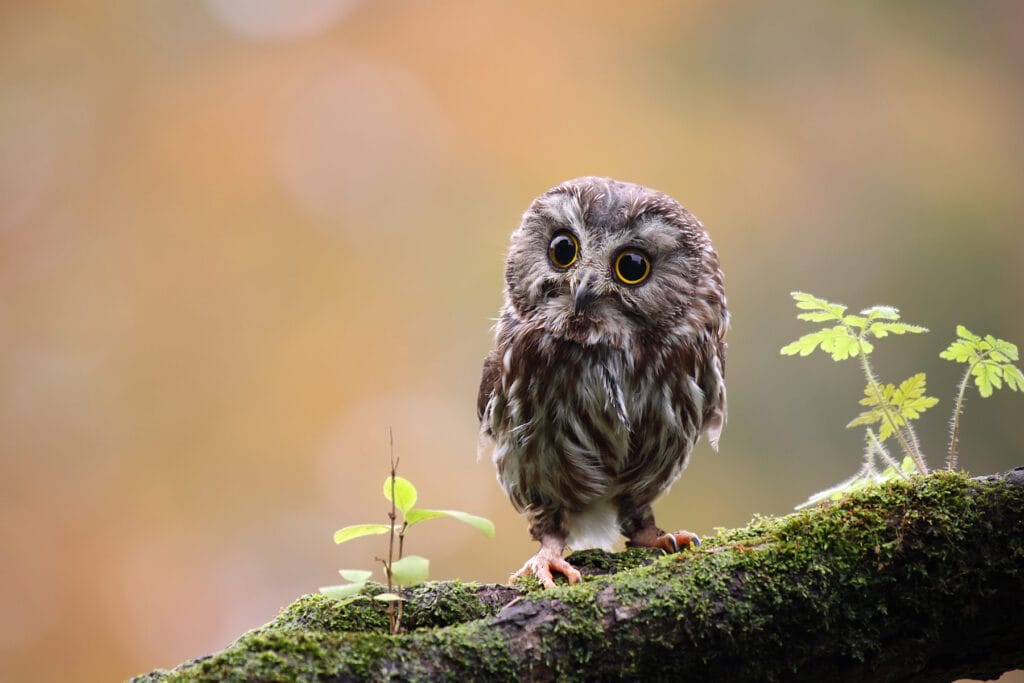
The Northern Saw-whet Owl, scientifically referred to as Aegolius acadicus, has a length of 7.1 to 8.3 inches (18 to 21 cm) and a wingspan of 16.5 to 18.9 inches (42 to 48 cm). It weighs around 2.3 to 5.3 ounces (65 to 151 g) and is among the smallest owl species you can come across in Florida.
Relative to their bodies, Northern Saw-whet Owls have large heads that are rounded and feature no ear tufts. Their plumage is mottled brown and their heads show tiny white spots.
Northern Saw-whet Owls are characterized by possessing a white facial disk accompanied by bright yellow eyes. The younglings of the species are also dark but their bellies and breasts are faded yellow.
Highly elusive and nocturnal by nature, Northern Saw-whet Owls can be tricky to spot. Luckily, they give a distinct call consisting of multiple sharp, penetrating sounds produced in succession that can help you pinpoint their location.
Northern Saw-whet owls like to roost in thick vegetation at the base of evergreen trees during the day. They also prefer breeding in dense forests, but sometimes they switch to more open areas.
Their diet typically includes shrews, deer mice, and voles.
8. Snowy Owl

If you’re a fan of the Harry Potter series, you’re probably in love with Hedwig; Harry’s pet/mail messenger. If you didn’t already know, that stunning bird belongs to the Snowy Owl species.
Also known as Bubo scandiacus in the scientific scene, these owls measure around 20.5 to 27.9 inches (52 to 71 cm) long and weigh between 56.4 to 104.1 ounces (1600 to 2950 g). They also have a wingspan ranging from 49.6 to 57.1 inches (126 to 145 cm).
Snowy Owls are big birds that are almost the same size as Great Horned Owls. They possess smooth, rounded heads with no ear tufts. Their bodies are on the bulky side with thick feathers covering their legs, which makes the base of the owl seem wide when sitting.
Top Tip: Snowy Owls get the name from their almost all-white plumage. They may show some brown or black markings on their white bodies -commonly particular in females-, resulting in a salt-and-pepper appearance.
Additionally, males of the species are typically paler and turn whiter with age. Snowy Owls prefer to breed in the treeless tundra of the arctic, which makes the migration season your best shot to see them in Florida.
Known for their hostile nature, these beautiful predators like to stay in open spaces close to the ground. They often perch on telephone poles, crests of dunes, and fence posts.
9. Long-eared Owl
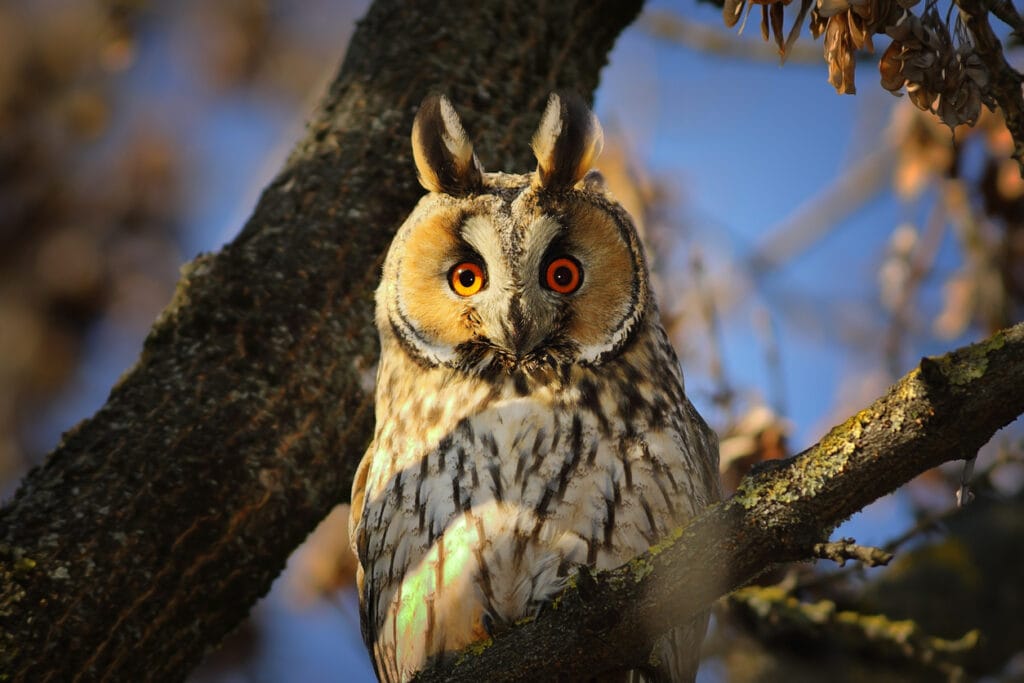
Scientifically called Asio otus, the Long-eared Owl has a length ranging from 13.8 to 15.8 inches (35 to 40 cm) and a wingspan around 35.4 to 39.4 inches (90 to 100 cm).
Weighing about 7.8 to 15.3 ounces (220 to 435 g), this species is bigger than Eastern Screech-Owls but smaller than Great Horned Owls. They have slim bodies and very prominent ear tufts.
Long-eared Owls also possess bright yellow eyes that seem to always be in a surprised expression. These birds have a mostly dark plumage with an orange or buff face as well as brown, black, and cream markings all over their wings, backs, and chests.
Another distinct physical feature of Long-eared Owls is the presence of 2 upright white lines between their eyes. Besides looks, this species is quite vocal as members produce a remarkable assortment of sounds including squeals, barks, and hoots.
Habitat-wise, Long-eared Owls like open areas such as grassland where they can forage. For roosting and nesting, they prefer thick, tall trees or shrubs.
10. Flammulated Owl

Last but not least, we have the Flammulated Owl, scientifically known as Psiloscops flammeolus. This is a very small species, even smaller than the Western Screech-Owl.
Flammulated Owls aren’t very common in Florida, but you can encounter them if you look hard enough. They measure 5.9 to 6.7 inches (15 to 17 cm) long and weigh around 1.5 to 2.2 ounces (43-63 g).
Flammulated Owls have a wingspan between 15.9 and 16.1 inches (40.5-41 cm). Appearance-wise, they’re a combination of grey, white, brown, and rust to serve as superior camouflage against tree bark.
Wrap Up
There you have it, a complete guide on the 10 species of owls in Florida and how you can find and recognize them.
FAQ
The Eastern Screech-Owl or the Barn Owl are probably the most common owls in Florida. It is always difficult to tell with owls as data about populations is difficult to come by. What we do know is that Florida is a good place to see a variety of owls.
We know that owls are generally nocturnal and difficult to see. Your best bet to see one in the day is the Burrowing Owl which is diurnal. That means it is active during daylight hours. To find out where they are, look at the explore species section of eBird for recent listings.
You may well be listening to the Limpkin, which is actually a waterbird. It has a mournful call that can be alarming and mistaken for an owl.




